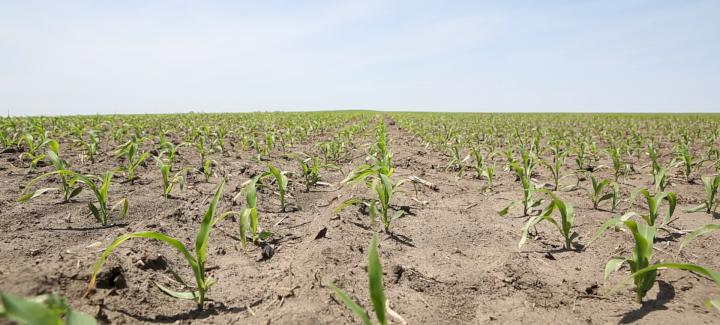
Last week, we reviewed the most common soybean diseases that have been robbing yields across the country. This week, we’re taking a look at the various corn diseases that impact growers’ fields year after year.
Common Corn Diseases
Seed decay, seedling blights and root rot are all early-season diseases to look for this spring. These diseases favor cold, wet soils and are particularly a problem with compacted soils. The most common pathogens that cause these issues are Fusarium and Pythium. Symptoms include stunted plants and wilting, and if you dig up the seed, you may notice brownish-black discoloration of the mesocotyl region, in addition to rotting seed and roots.
Anthracnose leaf blight thrives in hot, wet conditions. It survives on corn residue, so tillage is recommended to mitigate the disease. Controlling other diseases are also recommended as they can potentially exacerbate anthracnose leaf spot. Symptoms include oval-shaped lesions that first appear on the lower leaves, working their way up and turning black.
Common rust is environmental and prolific in cool, wet conditions. Some hybrids have resistance to this disease. Common rust should not cause significant yield damage, so control is not necessary. Symptoms include sporadic rust-colored pustules, which can be detected on both sides of the leaves.
Northern corn leaf blight thrives in cool, wet conditions and can be detected by tan streaks or lesions that appear parallel to the leaf structure. Many hybrids have resistance to northern corn leaf blight, but growers can use tillage to control infected residue. Rotation can help in no-till systems or reduced-till situations.
Physoderma brown spot is environmental and appears in hot, wet conditions. Tillage, managing residue and controlling other diseases are recommended to help prevent this disease. Symptoms appear as banded spots, usually yellow or brown in color.
Holcus leaf spot thrives in hot, wet conditions but can be controlled by managing residue. Spots appear as tan, dry, paper-like lesions. There is minimal economic damage with this disease.
Stewart’s wilt is a bacterial infection that spawns from corn flea beetles and results in tan- colored leaf streaks that appear cut or torn. There is hybrid resistance, but tillage should be used to control infected residue, as well as crop rotation in reduced or no-till systems.
Goss’ wilt is a bacterial infection from the soil that causes wavy lesions on the leaves that can exude a water-like substance. There is hybrid resistance, but tillage should be used to control infected residue, as well as crop rotation in reduced or no-till systems.
Anthracnose stalk and top dieback are vascular infections of leaf spot that thrive in hot, wet conditions. Growers can mitigate this disease by controlling other diseases in their crops and using tillage to get rid of the infected residue. Symptoms include discoloration of the plant and stalk rot.
Crazy top is a late-season soil-borne infection made worse through secondary infection and adverse growing conditions such as flooding with cool temps. No treatment is available for this condition. Just as the name alludes, plants infected with crazy top appear bushy on top, with distorted ear shoots and tassels.
Stalk rots are late season and environmental, and include gibberella, fusarium, diplodia and charcoal rots, to name a few. Signs of stalk rot may not show up until later in the season but are usually exacerbated by hot and wet or hot and dry conditions. The biggest indicator of stalk rot is brittle stalks. Some of the bacteria may form different colored fungus on the stalks as well. It’s recommended to utilize early applications of fungicides to mitigate stalk rots around the V6–V8 stages.
Ear molds are late season and environmental, and can be caused by the same pathogens that cause stalk rots, such as gibberella, fusarium, diplodia and aspergillus. Symptoms include different variations and colors of mold on the ear. There is some hybrid resistance to ear molds, but the best way to prevent the disease is through fungicides. Caution — this disease can produce mycotoxins that can affect livestock.
Gray leaf spot can overwinter on residue and pose a significant yield threat. It also thrives in hot, wet climates. There is some hybrid resistance to gray leaf spot. Symptoms are similar to other foliar diseases but can be recognized by the small, pinpoint lesions that form a yellowish halo around them that eventually produce much longer lesions. Strobilurin and triazole-type fungicides can be applied to help mitigate the disease.
Tar spot overwinters in corn residue and can thrive in hot, wet conditions. There is some hybrid resistance. Symptoms include small, raised black spots that resemble a fisheye and are scattered on both sides of the leaves. Tar spot cannot be scraped off the leave like some foliar pustules. Tar spot can cause significant yield loss. Crop rotation and residue management are recommended.
For more information on common corn diseases, reach out to your local Stine agronomist. University extension services also offer valuable advice on detection and mitigation strategies for these diseases.
Related Articles
-

Stine® to offer Syngenta’s Victrato® soybean seed treatment in 2026
December 2025 in Agronomy
-

Use Stine’s XP® seed treatments to prevent early injury to your crops
December 2025 in Agronomy
-

Understanding Stine’s enhanced oil profile soybeans
December 2025 in Agronomy
-

Soil sampling sets the stage for spring
November 2025 in Agronomy



